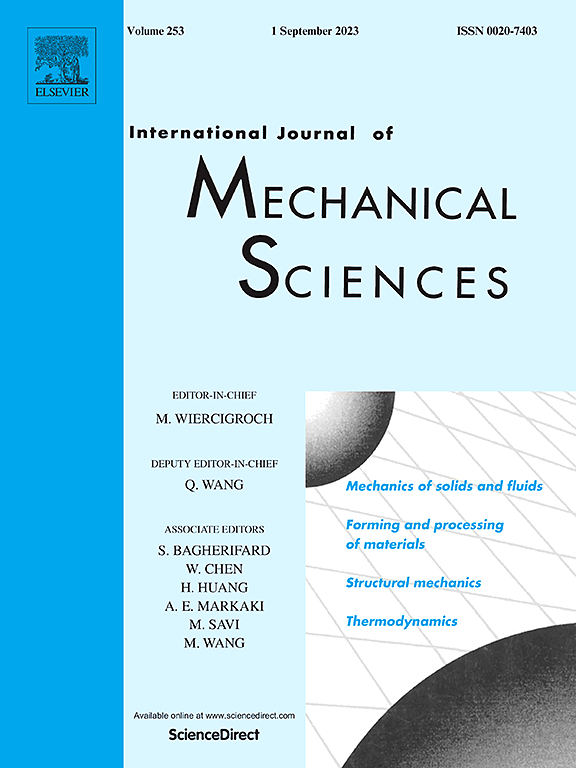A cutting tool wear data-physics fusion-driven monitoring method
IF 7.1
1区 工程技术
Q1 ENGINEERING, MECHANICAL
International Journal of Mechanical Sciences
Pub Date : 2025-06-22
DOI:10.1016/j.ijmecsci.2025.110526
引用次数: 0
Abstract
Tool wear monitoring (TWM) serves as a bridge between process information and tool condition. However, existing monitoring methods encounter limitations regarding long-term monitoring performance, and a single feedforward fusion approach often fails to consistently deliver high-precision predictions and reliable maintenance s1ort. In this paper, a TWM method based on Transformer-GRU and particle filter (TG-PF) driven by data-physics is proposed. Specifically, deep-level features are extracted from multi-source signals, and feature fusion is performed to accurately capture the tool's state changes. Based on the Transformer-GRU model, the mapping relationship between the historical series and the future tool wear is established, with the wear value obtained from the Transformer-GRU model serving as the observed value. The parameters of the physical model are updated during each iteration of the particle filter to achieve the fused prediction result. The fusion method incorporates a closed-loop dynamic error correction mechanism, mitigating long-term error accumulation and reducing prediction uncertainty. The TWM experiments conducted on thin-walled and rectangular block parts demonstrate that the prediction error of the fusion method is reduced by 19.19 % and 43.36 %, respectively, when compared to the single data-driven method, and the TG-PF method outperforms 11 advanced TWM methods. The fusion method leverages historical data and incorporates a dynamic updating mechanism, serving as a crucial approach to enhancing accuracy and mitigating uncertainty in long-term TWM.

一种刀具磨损数据物理融合监测方法
刀具磨损监测(TWM)是过程信息和刀具状态之间的桥梁。然而,现有的监测方法在长期监测性能方面存在局限性,单一的前馈融合方法往往无法始终如一地提供高精度预测和可靠的维护时间。提出了一种基于数据物理驱动的基于变压器- gru和粒子滤波(TG-PF)的TWM方法。具体而言,从多源信号中提取深层特征,并进行特征融合以准确捕获工具的状态变化。基于Transformer-GRU模型,建立了历史序列与未来刀具磨损的映射关系,并以Transformer-GRU模型得到的磨损值作为观测值。在粒子滤波的每次迭代过程中更新物理模型的参数,从而得到融合预测结果。融合方法采用闭环动态误差校正机制,减轻了长期误差积累,降低了预测的不确定性。在薄壁和矩形块件上进行的TWM实验表明,与单一数据驱动方法相比,融合方法的预测误差分别降低了19.19%和43.36%,TG-PF方法优于11种先进的TWM方法。融合方法利用历史数据,并结合动态更新机制,是提高长期TWM精度和减轻不确定性的关键方法。
本文章由计算机程序翻译,如有差异,请以英文原文为准。
求助全文
约1分钟内获得全文
求助全文
来源期刊

International Journal of Mechanical Sciences
工程技术-工程:机械
CiteScore
12.80
自引率
17.80%
发文量
769
审稿时长
19 days
期刊介绍:
The International Journal of Mechanical Sciences (IJMS) serves as a global platform for the publication and dissemination of original research that contributes to a deeper scientific understanding of the fundamental disciplines within mechanical, civil, and material engineering.
The primary focus of IJMS is to showcase innovative and ground-breaking work that utilizes analytical and computational modeling techniques, such as Finite Element Method (FEM), Boundary Element Method (BEM), and mesh-free methods, among others. These modeling methods are applied to diverse fields including rigid-body mechanics (e.g., dynamics, vibration, stability), structural mechanics, metal forming, advanced materials (e.g., metals, composites, cellular, smart) behavior and applications, impact mechanics, strain localization, and other nonlinear effects (e.g., large deflections, plasticity, fracture).
Additionally, IJMS covers the realms of fluid mechanics (both external and internal flows), tribology, thermodynamics, and materials processing. These subjects collectively form the core of the journal's content.
In summary, IJMS provides a prestigious platform for researchers to present their original contributions, shedding light on analytical and computational modeling methods in various areas of mechanical engineering, as well as exploring the behavior and application of advanced materials, fluid mechanics, thermodynamics, and materials processing.
 求助内容:
求助内容: 应助结果提醒方式:
应助结果提醒方式:


